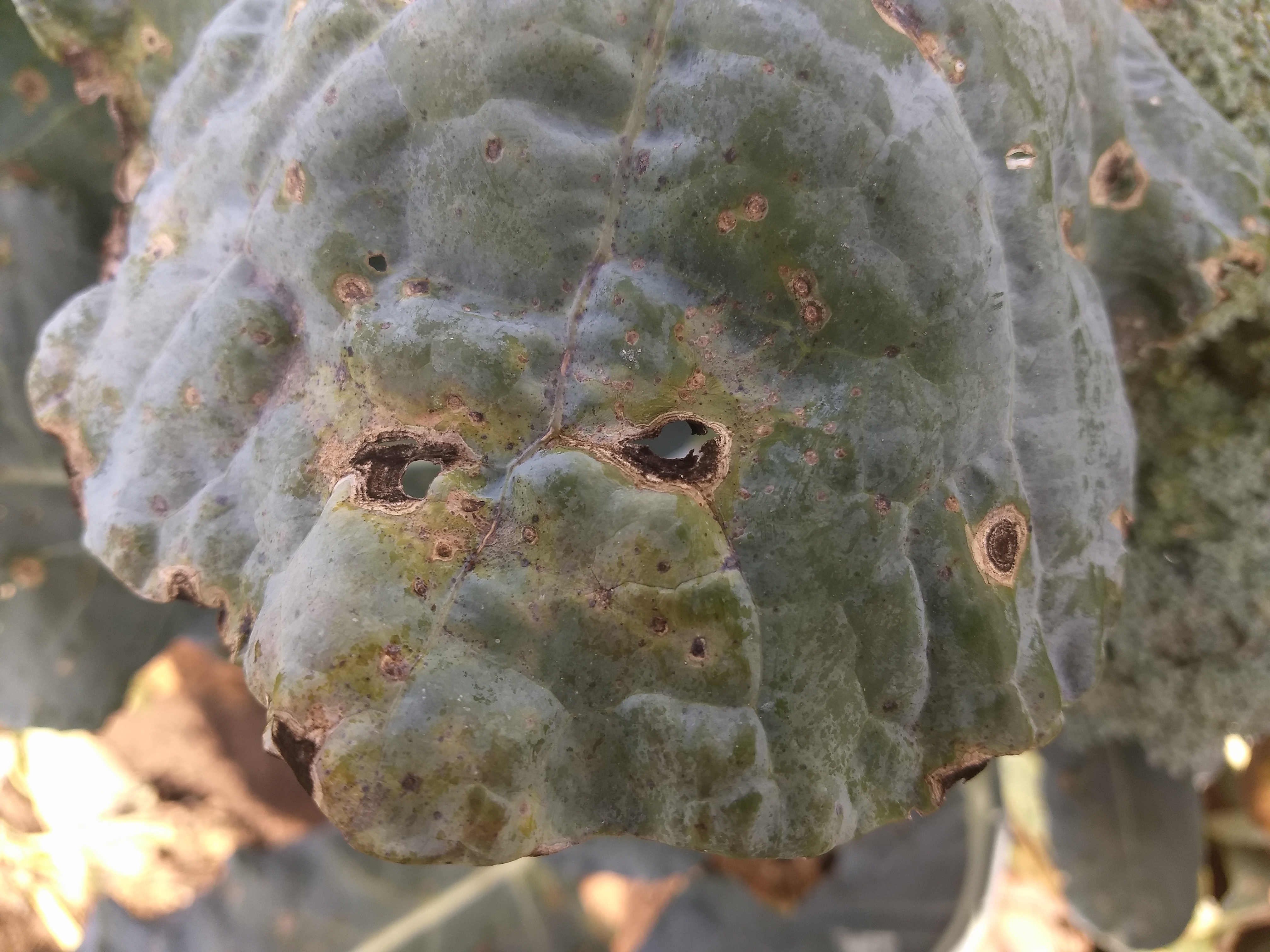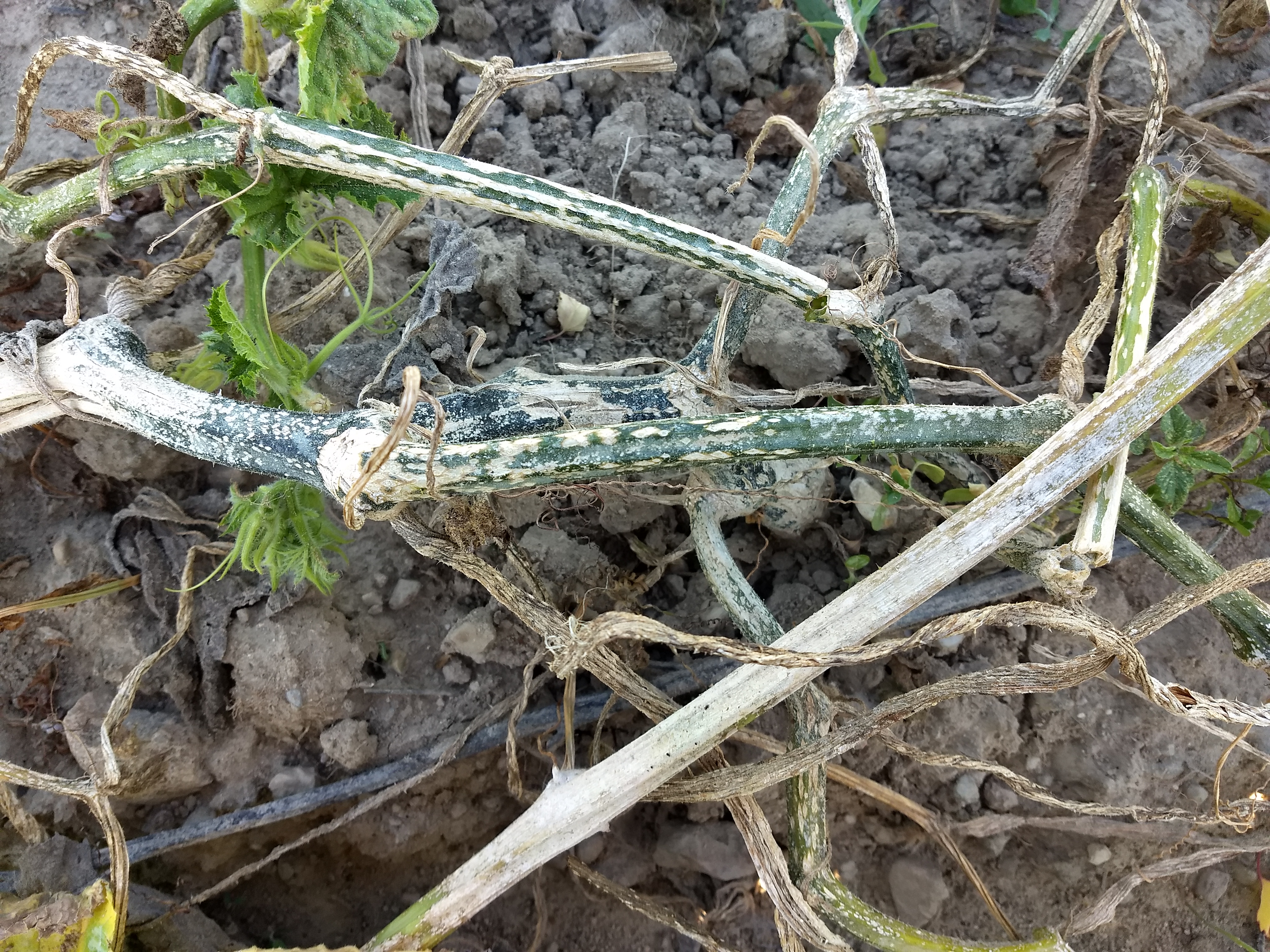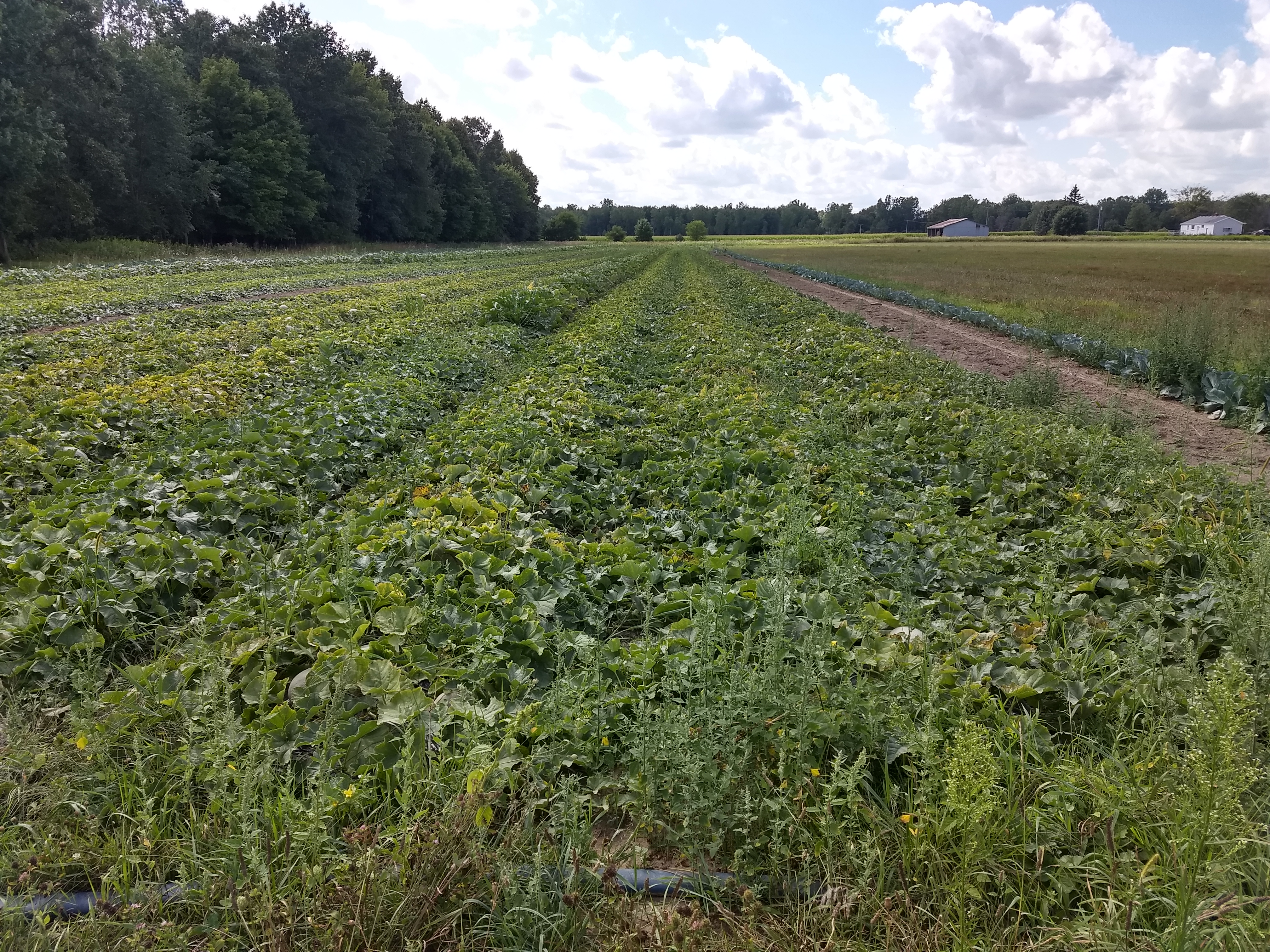East Michigan vegetable update – Aug. 21, 2019
The strange season continues as heavy-hitting diseases that we normally expect to see now take a backseat to a handful of oddball issues.

Weather
Most growers needed rain, and the eastern part of the Thumb and the Bay area has been listed as abnormally dry by the University of Nebraska Drought Monitor. This week brought some precipitation, and most sites got at least 0.3 inches this week, and some got up to 2 (Flint, Michigan) or 3 inches (Romeo, Michigan). There is a mixed chance of more rain today and early next week.
The forecast for early September is calling for cooler than normal temperatures, which is concerning for ripening pumpkins that were already planted late in many cases. The next few days are forecasted to have highs in the 70s, lows in the 50s and high 90% humidity. That will slow things down a bit, and will be an invitation for diseases to take hold. Symptoms from this infection period will not be apparent until next week.
You can find more detailed weather information for your area by visiting the Michigan State University Enviroweather station closest to you:
Here is a table that summarizes European corn borer activity, based on growing degree day models. I used Lapeer, Michigan as an example.
|
Current degree days (Lapeer) |
1,813 GDD |
|
Overwintering generation start to emerge and lay eggs |
450 GDD (occurred June 11) |
|
Peak flight and egg laying of overwintering generation |
700 GDD (occurred June 28) |
|
Peak flight and egg laying of first generation |
1,700 GDD (occurred Aug. 14) |
|
Peak flight and egg laying of second generation |
2,450 GDD |
Crops

Leaf blights caused by Alternaria species are showing up in multiple crops, including broccoli, cabbage, cauliflower, tomatoes, potatoes, melons and watermelons. This is an omnipresent group of fungi that makes brown lesions with concentric rings and black spores that can get crispy and fall out. They often bandwagon with other diseases and attack environmentally stressed plants as well. In general, these pathogens like warm nights over 60 degrees Fahrenheit and days around 80 F, with frequent dew periods. Infections seem to start on the oldest leaves and spread to the younger leaves. I have seen these infections worse in crop locations that have a windbreak like a tree line, a tall neighboring crop like corn or uncontrolled weeds.
In broccoli, cabbage and cauliflower, this pathogen causes head rots too, which can greatly impact pack out. In tomatoes and potatoes this pathogen is known as early blight, and it infects stems, leaves and fruit. In melons and watermelon, this pathogen can defoliate plants and allow the sun to burn the fruit. It can sometimes infect melon fruit, but that is not common.
As cousins in crime, Alternaria pathogens can be suppressed with some of the same fungicides on these different crops. Fungicides in FRAC, FRAC 7 and FRAC 11 are widely labeled for these pathogens in products with single or pre-mixed ingredients.
|
Product |
Mode of Action |
Rate |
PHI/REI |
|---|---|---|---|
|
Aprovia Top benzovindiflupyr + difenoconazole |
7 + 3 |
10.5-13.5 fluid ounces per acre in melons and tomatoes |
0 day/12 hour in melons and tomatoes |
|
Bravo Weatherstik chlorothalonil |
M5 |
1.5-2 pints per acre in melons and tomatoes 1.5 pints per acre in brassicas |
0 day/12 hour in melons and tomatoes 7 day/12 hour in brassicas |
|
Cabrio pyraclostrobin |
11 |
12-16 fluid ounces per acre in melons, tomatoes, and brassicas |
0 day/12 hour in melons, tomatoes, and brassicas |
|
Fontelis penthiopyrad |
7 |
12-16 fluid ounces per acre in melons 15-24 fluid ounces per acre in tomatoes 14-30 fluid ounces per acre in brassicas |
1 day/12 hour in melons 0 day/12 hour in tomatoes and brassicas |
|
Inspire Super cyprodinil + difenoconazole |
9 + 3 |
16-20 fluid ounces per acre in melons, tomatoes, and brassicas |
7 day/12 hour in melons and brassicas 0 day/12 hour in tomatoes |
|
Luna Experience fluopyram + tebuconazole |
7 + 3 |
6.0-17.0 fluid ounces per acre in melons 6.0-8.6 fluid ounces per acre in brassicas |
7 day/12 hour for melons and brassicas |
|
Luna Sensation fluopyram + trifloxystrobin |
7 + 11 |
5.0-7.6 fluid ounces per acre in melons and brassicas |
0 day/12 hour for melons and brassicas |
|
Switch cyprodinil + fludioxonil |
9 + 12 |
11-14 fluid ounces per acre in melons and brassicas |
1 day/12 hour in melons 0 day/12 hour in tomatoes 7 day/12 hour in brassicas |
|
Tanos cymoxanil + famoxadone |
27 + 11 |
6-8 ounces per acre in melons and tomatoes |
3 day/12 hour in melons and tomatoes |
Powdery mildew in vine crops has been operating at low-to-medium levels this year. Not as bad as I usually see it this time of year.

Plectosporium blight is a disease of pumpkins that can sometimes show up in fields that have not seen another crop in four or more years. I have seen it this year at such a place. Operations with a limited land base but a dedicated customer base for pumpkins can run into this from lack of an adequate time between pumpkin plantings in the same field. This pathogen attacks the leaf stalks and stems, as well as the pumpkin handles and the pumpkins themselves. Some powdery mildew products, like Aprovia Top and Inspire Super can slow the spread, but Quadris, Cabrio and Flint are also effective.
Tree fruit and berry growers are stuck on the same ground year in and year out. Pests attack and overwinter under or near the trees. That’s the deal. As an annual vegetable grower, you are not stuck in that deal. By choosing to grow the same crop on the same ground every year, you choose to build pest populations on your ground. It takes some creativity when rotating with leasers who may use atrazine, but it can be done.
Downy mildew has been slow to get started this year in our area. However, it was confirmed on commercial cucumber in Saginaw County yesterday, Aug. 20, despite a lack of spore catches in Bay or Saginaw counties over the previous six weeks. Crops near harvest should be destroyed soon after finishing them up, and crops with a few weeks left should get the good stuff, like Ranman or Orondis Opti to carry them through. I responded to calls to visit organic slicing cucumber and cantaloupe fields to look for downy mildew over the last two weeks and only found Alternaria. It’s been a lucky run.
Fruit rots caused by Rhizoctonia have popped in pickling cucumbers this week too. This pathogen is fairly widespread in soils and is triggered by long durations (24 hours) of fruit-to-soil contact when wet. It is kind of like trench foot on the underside of the fruit, hence its name “belly rot”. The pathogen infects the softened tissue at the soil line after rain followed by high humidity and high temperatures. It is not something that one can plan to spray for, and the fungicides are not easy to get onto the underside of the fruits. Maintaining a four-year rotation can minimize the inoculum from building up. The infection usually does not go much deeper than the skin, and dries out and scabs over when the conditions are unfavorable. This can result in some culls at the processor, but they not usually turn to mush from this pathogen alone.
Late blight caused by Phytophthora is now confirmed in multiple Wisconsin counties in both potatoes and tomatoes. Spore traps in Ontario are catching spores, but still no confirmed cases in Michigan or Ontario. The strain of late blight in Wisconsin is US23, which can be treated with mefenoxam (Ridomil) if disease pressure overcomes protectant fungicides like chlorothalonil (Bravo).
Onion thrips numbers are very high, with untreated onions looking ghastly white and small.
Cucumber beetles are in high numbers at some farms. It is important to control these to prevent bacterial wilt from killing plants, and also to protect the fruits from the scarring that the beetles make from feeding on them.
Squash bugs seem to be everywhere this year. They suck plant juices out with their straw-like mouths, which can cause wilts and leaf death that resembles drought stress and a variety of diseases. A close inspection of plants with dying leaves can usually reveal if squash bugs are the problem. Their eggs are bronze-colored footballs arranged in geometric patterns. Their nymphs look like large gray aphids, and they are fast. Adults are larger, but are harder to find.
Caterpillars in sweet corn have eased up in some areas without a major change in spray schedules. This could be because of field corn silking. If you want to know exactly which worms are in the ears, MSU entomologist Christina Difonzo made this nice tip sheet to help in identifying late-season caterpillars feeding in the ear, like European corn borer, western bean cutworm and corn earworm.
Flea beetles are in high numbers in heading and leafy brassicas right now on some farms. On a visit on Monday, one broccoli field appeared to be under heavy attack, while the Lacinato and Siberian kale, cauliflower and cabbage nearby where just fine.
Tip burn in cauliflower is showing up right now, likely as a result of environmental stress. This is a calcium deficiency caused by uneven water availability. I also received a report of internal blossom end rot in Roma tomatoes earlier this month. It is well-known that Romas get blossom end rot more often than other varieties, but it is a bit of a mystery as to why blossom end rot sometimes only shows up on the inside of the fruit. Both forms of blossom end rot are caused by calcium deficiency from uneven water availability.

Yellow leaves and dieback symptoms in vine crops are showing up right now. There can be many reasons for this. Closely inspect plants along their leaves, stems and root crowns for signs of squash bugs and cucumber beetles. Diseases that can cause these symptoms include Fusarium, Plectosporium and Didymella, but they will also cause stem signs. Fusarium will cause the tissue just under the surface of the stem to turn brown. Plectosporium will cause the stems to have diamond-shaped lesions with a dark wet border that can merge to form large scabby sections of vine. Didymella can cause soft brown lesions on stems that can turn scabby and reddish droplets of plant sap.
If you can look down the row and see a pattern to the leaf stress: (all in the oldest leaves, on a hilltop or sandy area, for example), then you are likely looking at a stressful environmental condition causing the wilting and leaf dieback. Many root systems were compromised this spring with crops mudded in, and I have seen both cantaloupe and pumpkin fields in the last week showing this pattern of stress. I have also seen pumpkin plants showing these symptoms because they already had a full load of orange-ripe fruit on them. These plants are simply dying because their job is done.
Early ripening pumpkins can be cured and stored until more favorable marketing times, if you have the space. An ideal space is covered and well-ventilated at 75-85 F for two weeks. Field curing in piles or rows in the field for two to three weeks is not as ideal because of rain potentially causing or spreading disease and sun burn on the fruits. It would be a shame to waste these early fruit when so many other growers are sweating bullets hoping their delayed plantings will yield.
Get togethers
It is never too early to make accommodations to attend the Great Lakes Fruit, Vegetable and Greenhouse Growers EXPO, Dec. 10-12 in Grand Rapids, Michigan. Hotel blocks are open and tend to go fast. The combination of grower-focused, research-backed presentations and an exhibit hall featuring a diverse set of vendors make it a can’t-miss event.
Produce Safety Alliance Grower trainings are scheduled for this fall and winter. Pre-registration is required. View the dates, locations and register online.
Please contact me at phill406@msu.edu or 616-901-7513 with questions, concerns, or to schedule a farm visit. You can also send plant materials to MSU Diagnostic Services.



 Print
Print Email
Email




